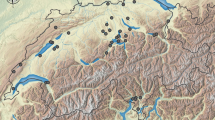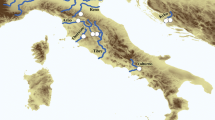Abstract
Molecular systematic studies provide evidence for three new species of Bathymodiolus-like hydrothermal vent mussels (Bivalvia: Mytilidae) from relatively shallow waters (depth less than 750 m) associated with the Kermadec Arc off northern New Zealand. Mitochondrial COI sequences from the three putative new species differed substantially from those of other known bathymodiolin species from the Pacific and Indian Oceans. Population genetic analysis of one of these species (Bathymodiolus new species NZ-1) revealed heterogeneity in allozyme gene frequencies between samples collected from two seamounts about 50 km apart. Factors that might contribute to genetic differentiation between neighbouring seamounts are discussed.



Similar content being viewed by others
References
Birky CW Jr, Fuerst P, Maruyama T (1983) Organelle diversity under migration, mutation, and drift: equilibrium expectations, approach to equilibrium, effects of heteroplasmic cells, and comparison to nuclear genes. Genetics 121:613–627
Black MB, Halanych KM, Maas PAY, Hoeh WR, Hashimoto J, Desbruyères D, Lutz RA, Vrijenhoek RC (1997) Molecular systematics of vestimentiferan tube worms from hydrothermal vents and cold-water seeps. Mar Biol 130:141–149
Boehlert GW, Mundy BC (1993) Ichthyoplankton assemblages at seamounts and oceanic islands. Bull Mar Sci 53:336–361
Clark MR, O’Shea S (2001) Hydrothermal vent and seamount fauna from the southern Kermadec Ridge, New Zealand. InterRidge News 10:14–17
Comtet T, Desbruyères D (1998) Population structure and recruitment in mytilid bivalves from the Lucky Strike and Menez Gwen hydrothermal fields (37° 17′ N and 37° 50′ N on the Mid-Atlantic Ridge). Mar Ecol Prog Ser 163:165–177
Cosel R von (2002) A new species of bathymodioline mussel (Mollusca, Bivalvia, Mytilidae) from Mauritania (West Africa), with comments on the genus Bathymodiolus Kenk & Wilson, 1985. Zoosystema 24:259–271
Cosel R von, Karine O (1998) Gigantism in Mytilidae. A new Bathymodiolus from cold seep areas on the Barbados accretionary Prism. Anim Biol 321:655–663
Cosel R von, Métivier B, Hashimoto J (1994) Three new species of Bathymodiolus (Bivalvia: Mytilidae) from hydrothermal vents in the Lau basin and the North Fiji basin, western Pacific, and the Snake pit area, mid-Atlantic ridge. Veliger 37:374–392
Cosel R von, Comtet T, Krylova E (1997) Two new species of Bathymodiolus from hydrothermal vents on the Mid-Atlantic Ridge. Cah Biol Mar 38:145–146
Cosel R von, Comtet T, Krylova E (1999) Bathymodiolus (Bivalvia: Mytilidae) from hydrothermal vents on the Azores Triple Junction and the Logatchev Hydrothermal Field, Mid-Atlantic Ridge. Veliger 42:218–248
Craddock C, Hoeh WR, Gustafson RG, Lutz RA, Hashimoto J, Vrijenhoek RJ (1995a) Evolutionary relationships among deep-sea mytilids (Bivalvia: Mytilidae) from hydrothermal vents and cold-water methane/sulfide seeps. Mar Biol 121:477–485
Craddock C, Hoeh WR, Lutz RA, Vrijenhoek RC (1995b) Extensive gene flow in the deep-sea hydrothermal vent mytilid Bathymodiolus thermophilus. Mar Biol 124:137–146
Distel DL, Baco AR, Chuang E, Morrill W, Cavanaugh C, Smith CR (2000) Marine ecology: Do mussels take wooden steps to deep-sea vents? Nature 403:725
Doyle JJ, Dickson E (1987) Preservation of plant samples for DNA restriction endonuclease analysis. Taxon 36:715–722
Elliott NG, Ward RD (1992) Enzyme variation in orange roughy (Hoplostethus atlanticus) samples from southern Australian and New Zealand waters. Aust J Mar Freshw Res 45:51–67
Felsenstein J (1985) Confidence limits on phylogenies: an approach using the bootstrap. Evolution 39:783–791
Folmer O, Black M, Hoeh W, Lutz R, Vrijenhoek R (1994) DNA primers for amplification of mitochondrial cytochrome C oxidase subunit I from metazoan invertebrates. Mol Mar Biol Technol 3:294–299
Foltz DW (1986) Null alleles as a possible cause of heterozygote deficiencies in the oyster Crassostrea virginica and other bivalves. Evolution 40:869–870
Gaffney PM, Scott TM, Koehn RK, Diehl WJ (1990) Interrelationships of heterozygosity, growth rate and heterozygote deficiencies in the coot clam, Mulinia lateralis. Genetics 124:687–699
Grassle JP (1985) Genetic differentiation in populations of hydrothermal vent mussels (Bathymodiolus thermophilus) from the Galapagos Rift and 13° N on the East Pacific Rise. Bull Biol Soc 6:429–442
Gustafson RG, Turner RD, Lutz RA, Vrijenhoek RC (1998) A new genus and five new species of mussels (Bivalvia, Mytilidae) from deep-sea sulfide/hydrocarbon seeps in the Gulf of Mexico. Malacologia 40:63–112
Hall TA (1999) Bioedit: a user friendly biological sequence alignment editor and analysis programme for Windows 95/98/NT. Nucleic Acids Symp Ser 41:95–98
Hashimoto J, Okutani T (1994) Four new mytilid mussels associated with deepsea chemosynthetic communities around Japan. Venus 53:61–83
Hebert PDN, Beaton MJ (1989) Methodologies for allozyme analysis using cellulose acetate electrophoresis. Helena Laboratories, Beaumont, Tex.
Jacobs DK, Lindberg DR (1998) Oxygen and evolutionary patterns in the sea: Onshore/offshore trends and recent recruitment of deep-sea faunas. Proc Natl Acad Sci USA 95:9396–9401
Kenk VC, Wilson BR (1985) A new mussel (Bivalvia, Mytilidae) from hydrothermal vents in the Galapagos Rift zone. Malacologia 26:253–271
Kumar S, Tamura K, Jakobsen I, Nei M (2001) MEGA2: Molecular evolutionary genetics analysis software, 2.01. Arizona State University, Tempe, AZ, USA
Le Pennec M, Beninger PG (1997) Ultrastructural characteristics of spermatogenesis in three species of deep-sea hydrothermal mytilids. Can J Zool 75
Lewis KB, Marshall BA (1996) Seep faunas and other indicators of methane-rich dewatering on New Zealand convergent margins. NZ J Geol Geophys 39:181–200
Li G, Hedgecock D (1998) Genetic heterogeneity, detected by PCR-SSCP, among samples of larval Pacific oysters (Crassostrea gigas) supports the hypothesis of large variance in reproductive success. Can J Fish Aquat Sci 55:1025–1033
Little CTS (2002) The fossil record of hydrothermal vent communities. Cah Biol Mar 43:313–316
Little CTS, Vrijenhoek RC (2003) Are hydrothermal vent animals living fossils? Trends Ecol Evol 18:582–588
Lutz RA, Rhoads DC, Jablonski D, Turner RD (1979) High larval dispersal capability of a deep-sea hydrothermal vent bivalve from the Galapagos Rift. Am Zool 19:927
Nei M (1978) Estimation of average heterozygosity and genetic distance from a small number of individuals. Genetics 89:583–590
O’Mullan GD, Maas PAY, Lutz RA, Vrijenhoek RC (2001) A hybrid zone between hydrothermal vent mussels (Bivalvia: Mytilidae) from the Mid-Atlantic Ridge. Mol Ecol 10:2819–2831
Ou HW (1991) Some effects of seamounts on oceanic flows. J Phys Oceanogr 21:1835–1845
Parson LM, Wright IC (1996) The Lau-Havre-Taupo back-arc basin: a southward-propagating, multi-stage evolution from rifting and spreading. Tectonophysics 263:1–22
Peek A, Gustafson R, Lutz R, Vrijenhoek R (1997) Evolutionary relationships of deep-sea hydrothermal vent and cold-water seep clams (Bivalvia: Vesicomyidae): Results from the mitochondrial cytochrome oxidase subunit I. Mar Biol 130:151–161
Peek AS, Gaut BS, Feldman RA, Barry JP, Kochevar RE, Lutz RA, Vrijenhoek RC (2000) Neutral and nonneutral mitochondrial genetic variation in deep sea clams from the family Vesicomyidae. J Mol Evol 50:141–153
Perissinotto R, Rae CMD (1990) Occurrence of anticyclonic eddies on the Price Edward Plateau (Southern Ocean): effects on phytoplankton biomass and production. Deep Sea Res 37A: 777–793
Posada D, Crandall KA (1998) MODELTEST: testing the model of DNA substitution. Bioinformatics 14:817–818
Raymond M, Rousset F (1995) GENEPOP (version 2.1): population genetic software for exact tests and ecumenicism. J Hered 86:248–249
Rice WR (1989) Analyzing tables of statistical tests. Evolution 43:223–225
Richer de Forges BR, Koslow AJ, Poore GCB (2000) Diversity and endemism of the benthic seamount fauna in the southwest Pacific. Nature 405:944–947
Roff DA, Bentzen P (1989) The statistical analysis of mitochondrial DNA polymorphisms: χ2 and the problem of small samples. Mol Biol Evol 6:539–545
Ronde CEJ de, Baker ET, Massothy GJ, Lupton JE, Wright IC, Feely RA, Greene RR (2001) Intra-oceanic subduction-related hydrothermal venting, Kermadec volcanic arc, New Zealand. Earth Planet Sci Lett 193:359–369
Shomura RS, Barkley RA (1980) Ecosystem dynamics of seamounts—a working hypothesis. In: Proceedings of the 4th symposium for the cooperative study of the Kuroshio and adjacent regions. The Japan Academy, Tokyo
Swofford DL (2000) PAUP: phylogenetic analysis using parsimony, version 4.0. Smithsonian Institution and Sinauer, Sunderland, Mass., USA
Taggart JB, Hynes RA, Prodohl PA, Ferguson A (1992) A simplified protocol for routine total DNA isolation from salmonid fishes. J Fish Biol 40: 963–965
Thiriot-Quievreux C, Noel T, Bougrier S, Dallot S (1988) Relationships between aneuploidy and growth rate in pair matings of the oyster Crassostrea virginica. Aquaculture 75:89–96
Tunnicliffe V (1991) The biology of hydrothermal vents: ecology and evolution. Oceanogr Mar Biol Annu Rev 29:319–407
Van Dover CL (2000) The ecology of deep-sea hydrothermal vents. Princeton University Press, Princeton, NJ
Van Dover CL, Humphris SE, Fornari D, Cavanaugh CM, Collier R, Goffredi SK, Hashimoto J, Lilley CM, Reysenbach AL, Shank TM, Von Damm KL, Banta A, Gallant RM, Götz D, Green D, Hall J, Harmer TL, Hurtado LA, Johnson P, McKiness ZP, Meredith C, Olson E, Pan IL, Turnipseed M, Won Y, Young III CR, Vrijenhoek RC (2001) Biogeography and ecological setting of Indian Ocean hydrothermal vents. Science 294:818–823
Van Dover CL, German CR, Speer KG, Parson LM, Vrijenhoek RC (2002) Evolution and biogeography of deep-sea vent and seep invertebrates. Science 295:1253–1257
Vinogradova NG (1997) Zoogeography of the abyssal and hadal zones. Adv Mar Biol 32:325–385
Won Y (2003) Molecular Systematics, Population Structure, and Gene Flow of Deep-sea Hydrothermal Vent Mussels (Mytilidae: Bathymodiolus) and Associated Sulfur-Oxidizing Endosymbionts. Ph.D. Graduate Program in Ecology and Evolution, New Brunswick, N.J., USA
Won Y, Maas PAY, Dover CLV, Vrijenhoek RC (2002) Habitat reversal in vent and seep mussels: seep species, Bathymodiolus heckerae, derived from vent ancestors. Cah Biol Mar 34:387–390
Won Y, Young CR, Lutz RA, Vrijenhoek RC (2003) Dispersal barriers and isolation among deep-sea mussel populations (Mytilidae: Bathymodiolus) from eastern Pacific hydrothermal vents. Mol Ecol 12:169–184
Zaykin DV, Pudovkin AI (1993) Two programs to estimate significance of χ2 values using pseudo-probability tests. J Hered 84:152–153
Acknowledgements
We are grateful to Dr. Cornel de Ronde, Institute of Geological and Nuclear Sciences, for collection of the Macauley Cone specimens; Dr. Steve O’Shea, NIWA, for the RV and RIII May specimens; and the Ministry of Fisheries Observer Programme for the Cape Turnagain specimens. RIII November 2000 specimens were collected by one of us (PJS). Ashley Rowden, NIWA, is acknowledged for comments on the manuscript, as are three anonymous referees. This research was supported by grants from the New Zealand Foundation for Research, Science and Technology (contract number C01X0028), the US National Science Foundation (OCE9910799), and the David and Lucille Packard Foundation.
Author information
Authors and Affiliations
Corresponding author
Additional information
Communicated by M.S. Johnson, Crawley
Rights and permissions
About this article
Cite this article
Smith, P.J., McVeagh, S.M., Won, Y. et al. Genetic heterogeneity among New Zealand species of hydrothermal vent mussels (Mytilidae: Bathymodiolus). Marine Biology 144, 537–545 (2004). https://doi.org/10.1007/s00227-003-1207-4
Received:
Accepted:
Published:
Issue Date:
DOI: https://doi.org/10.1007/s00227-003-1207-4




